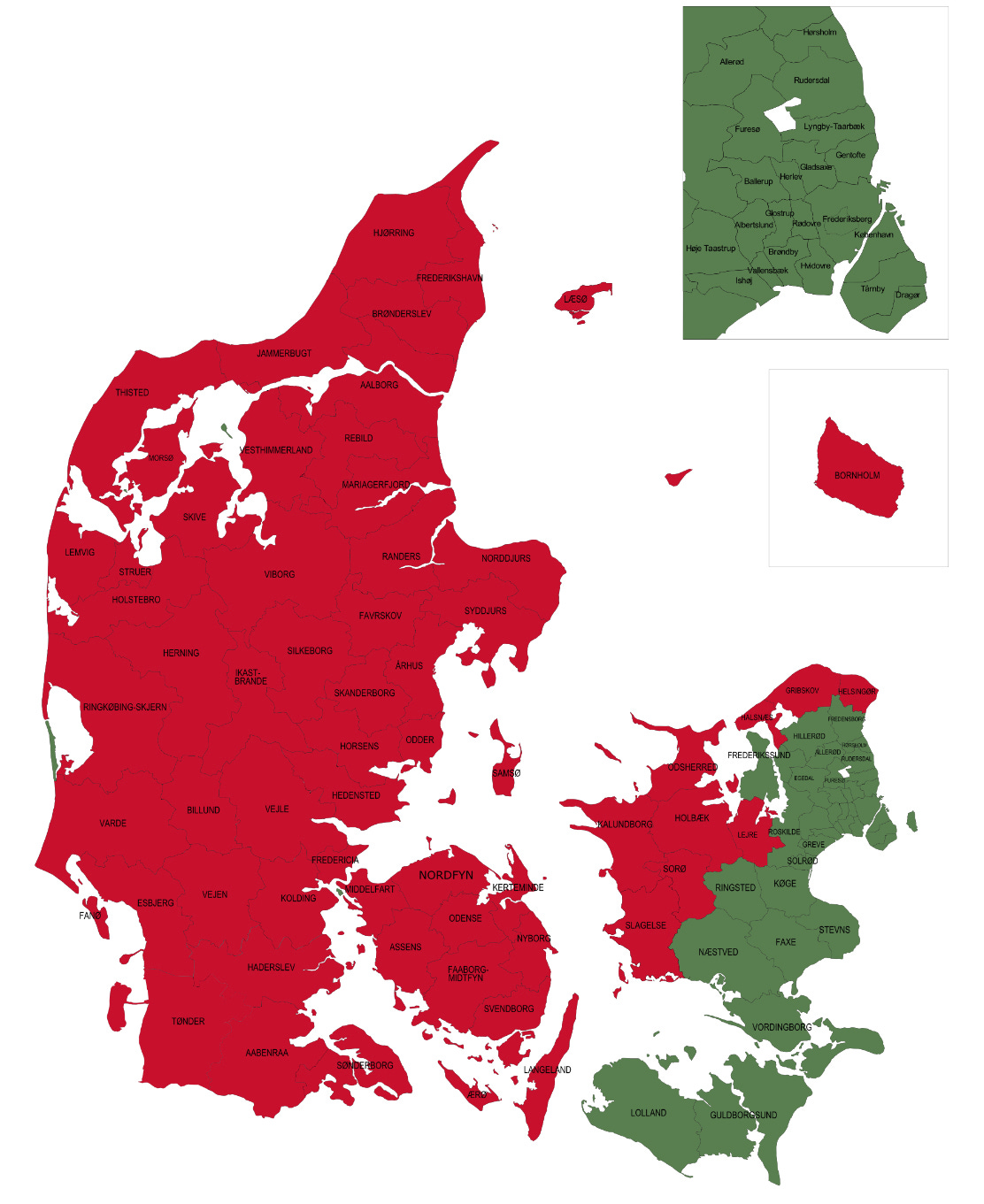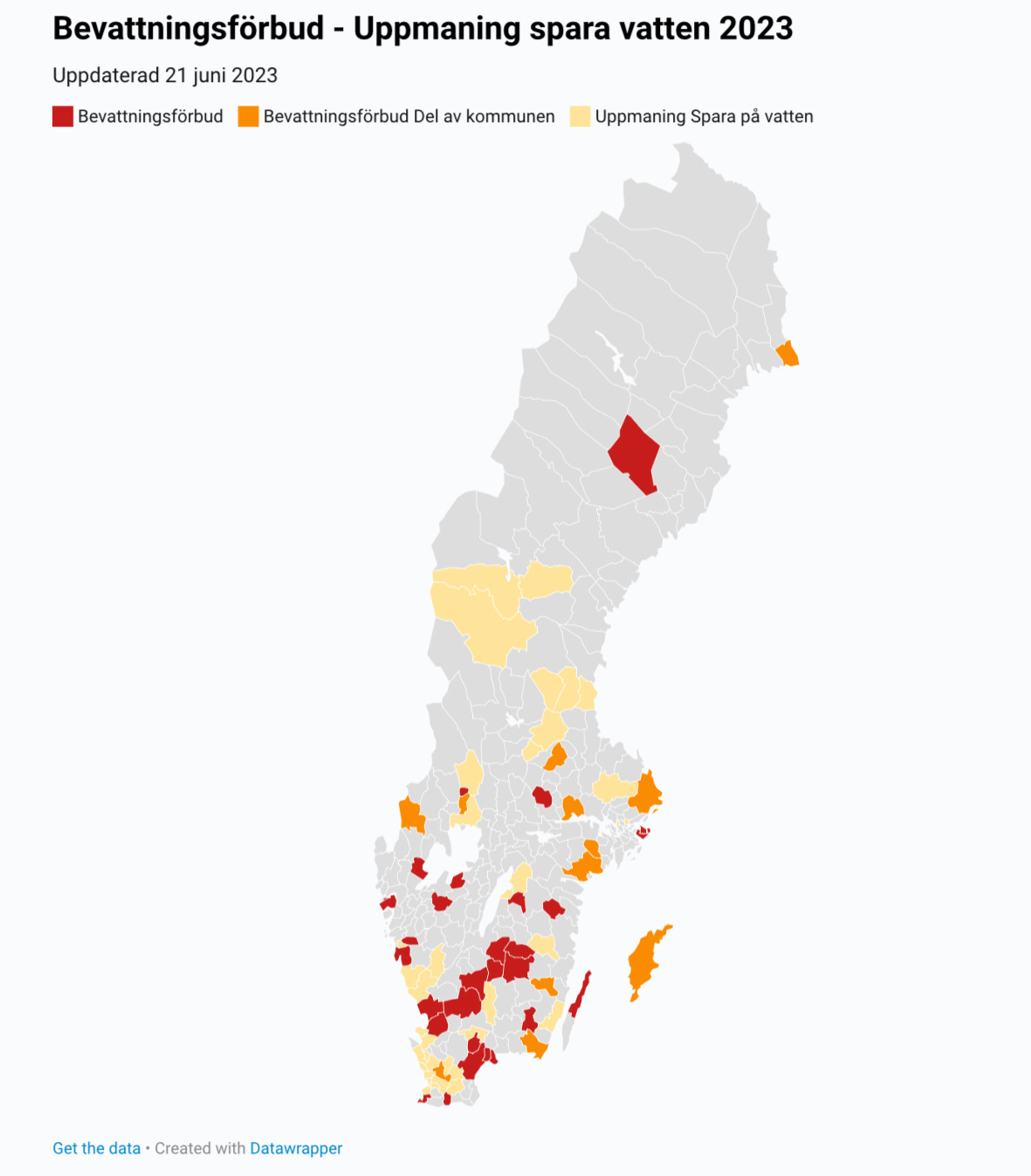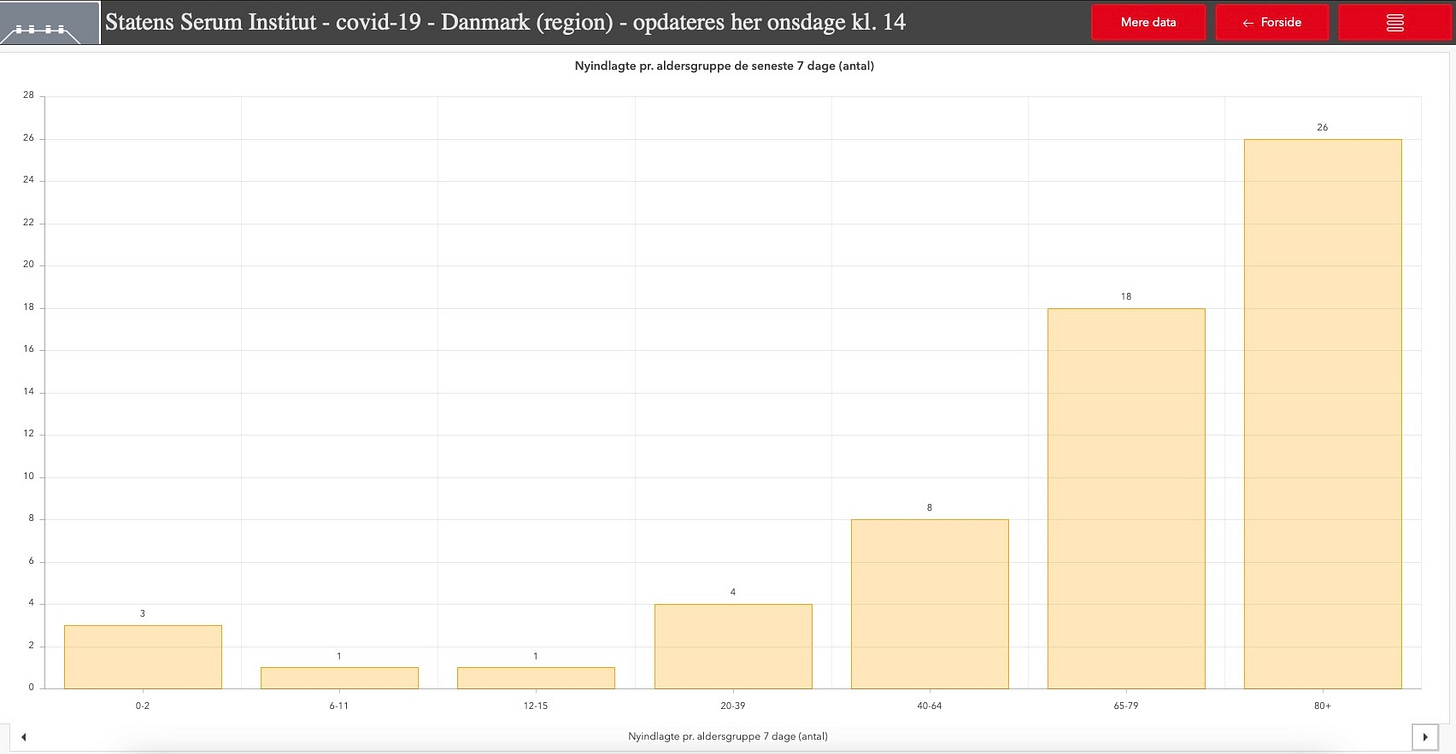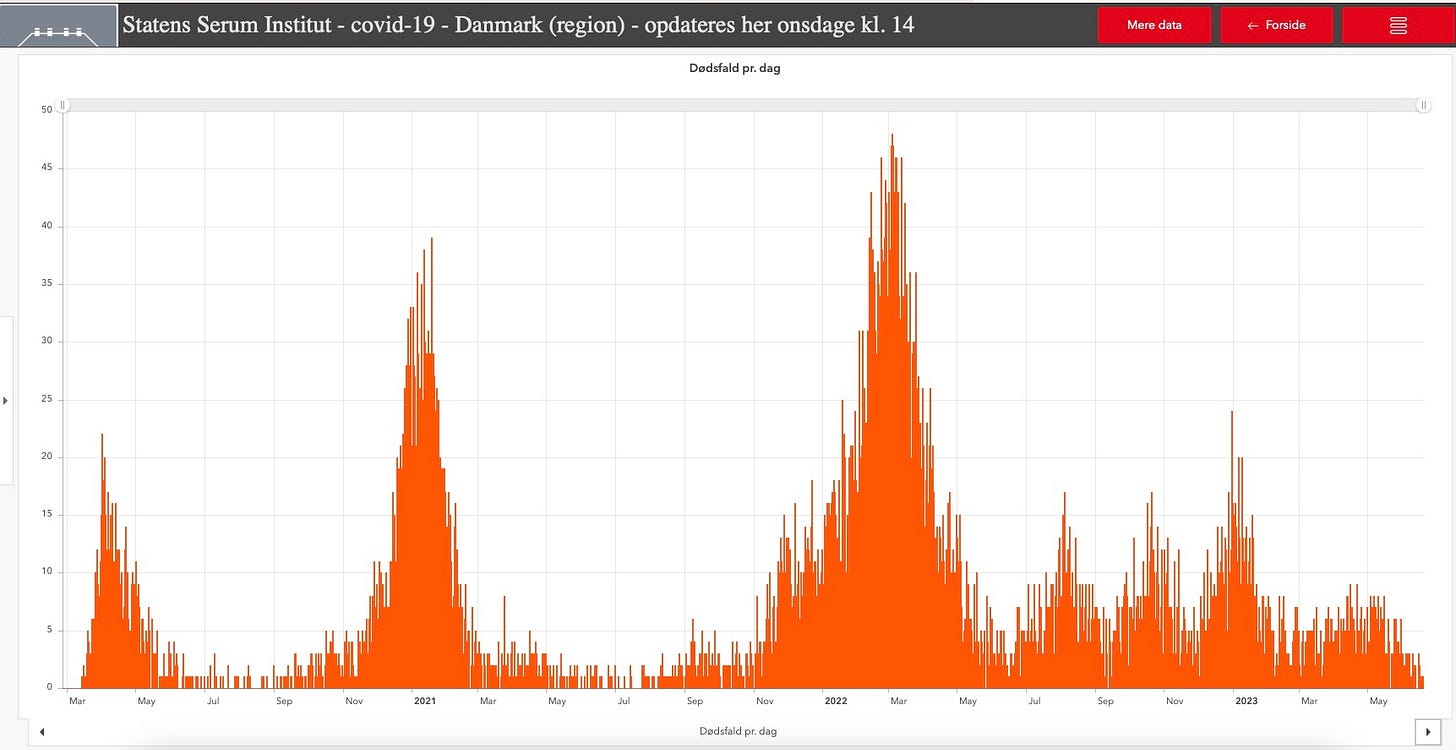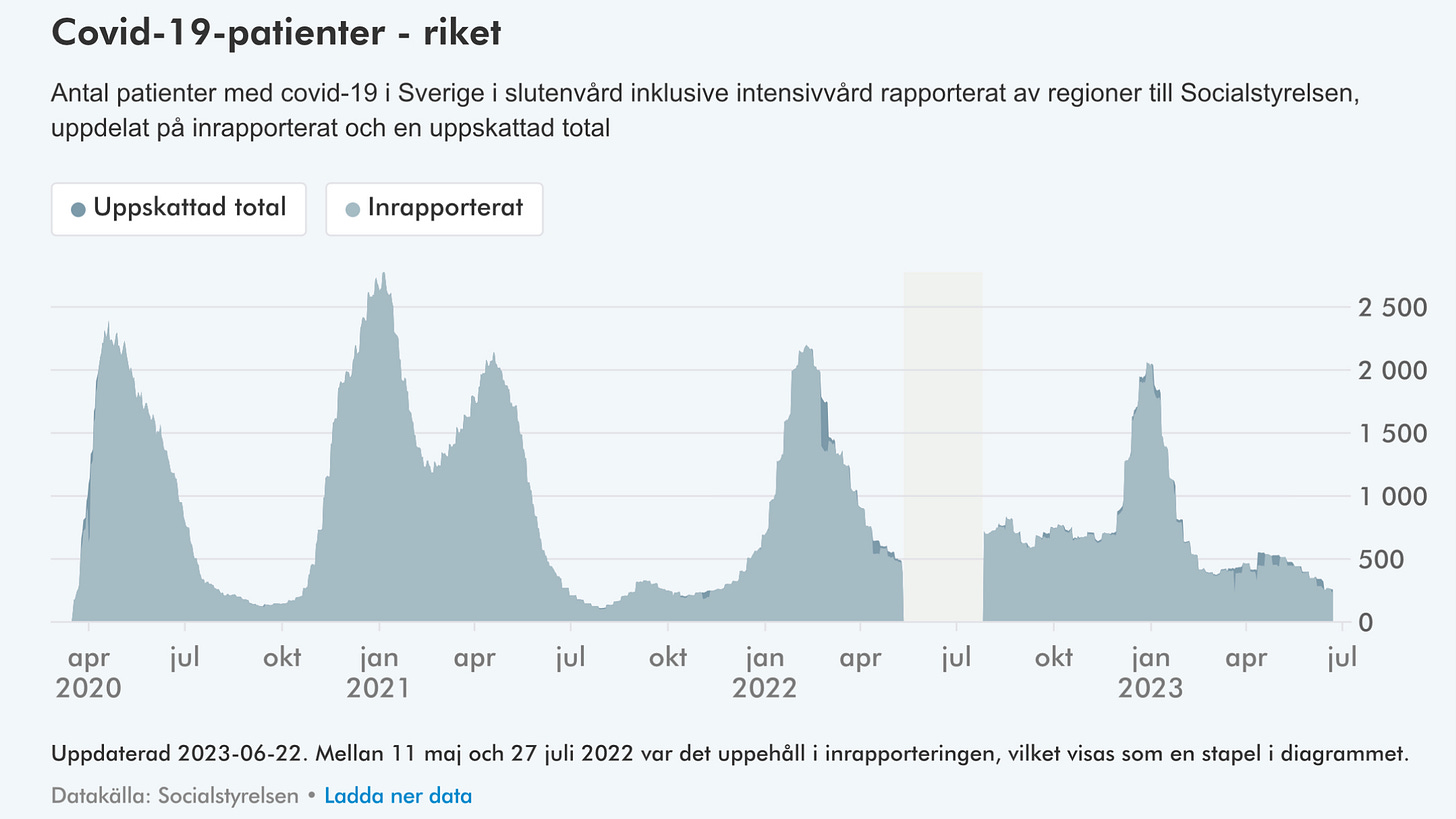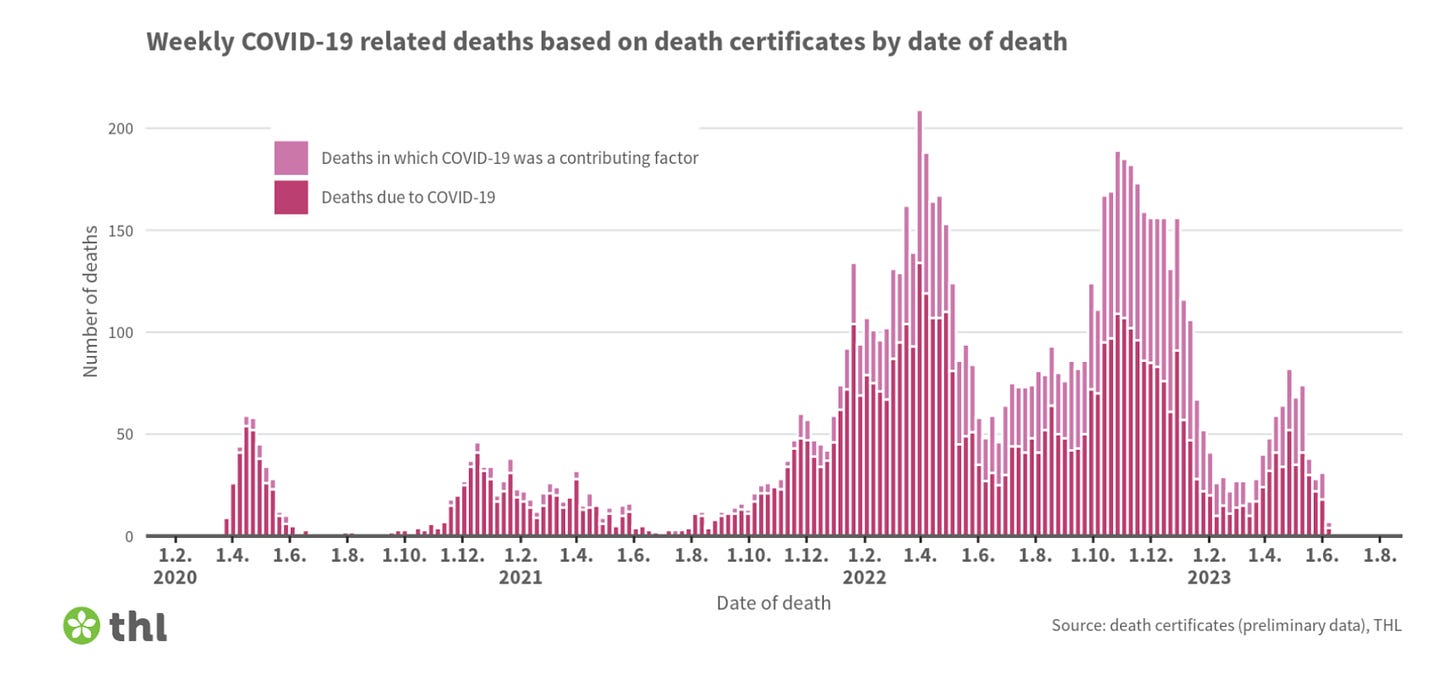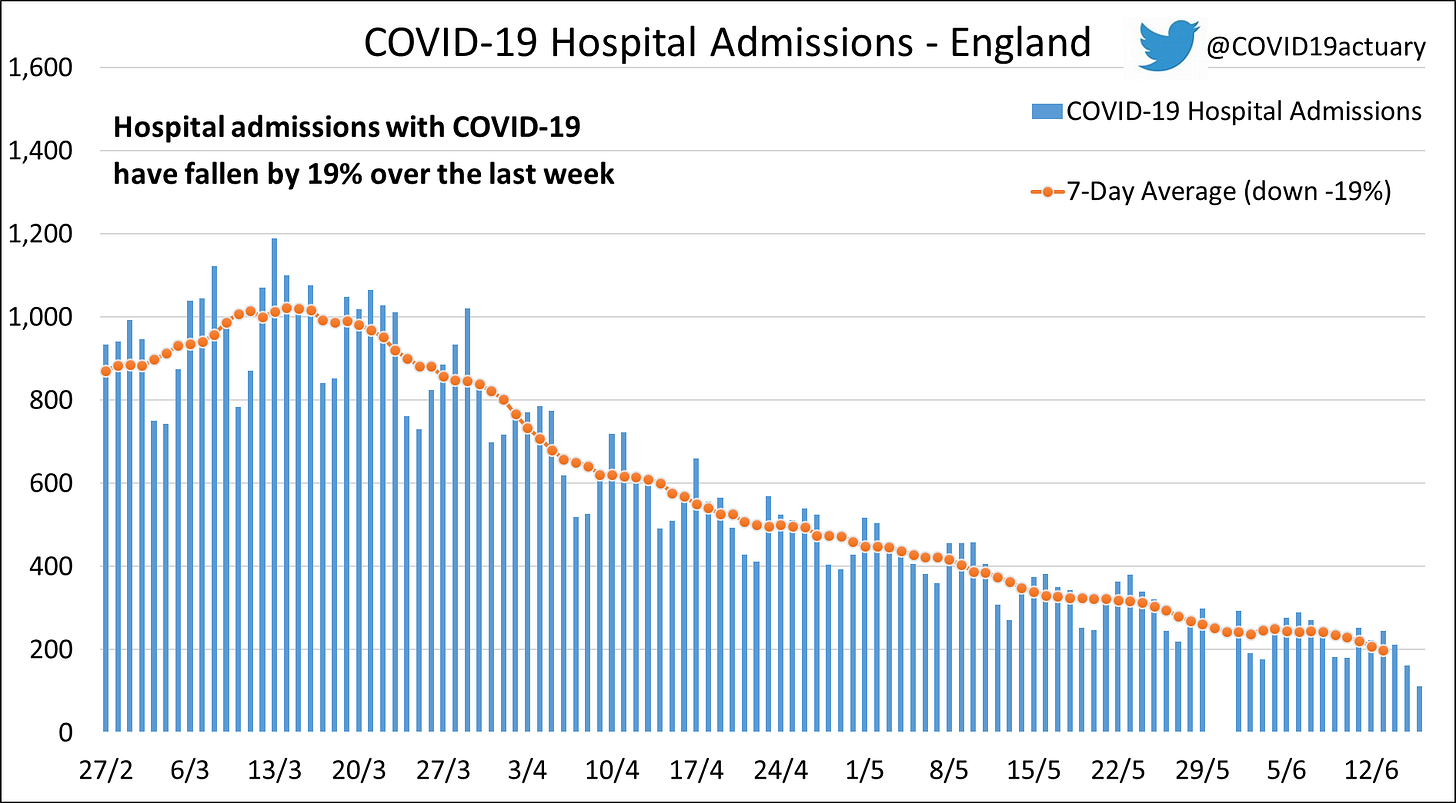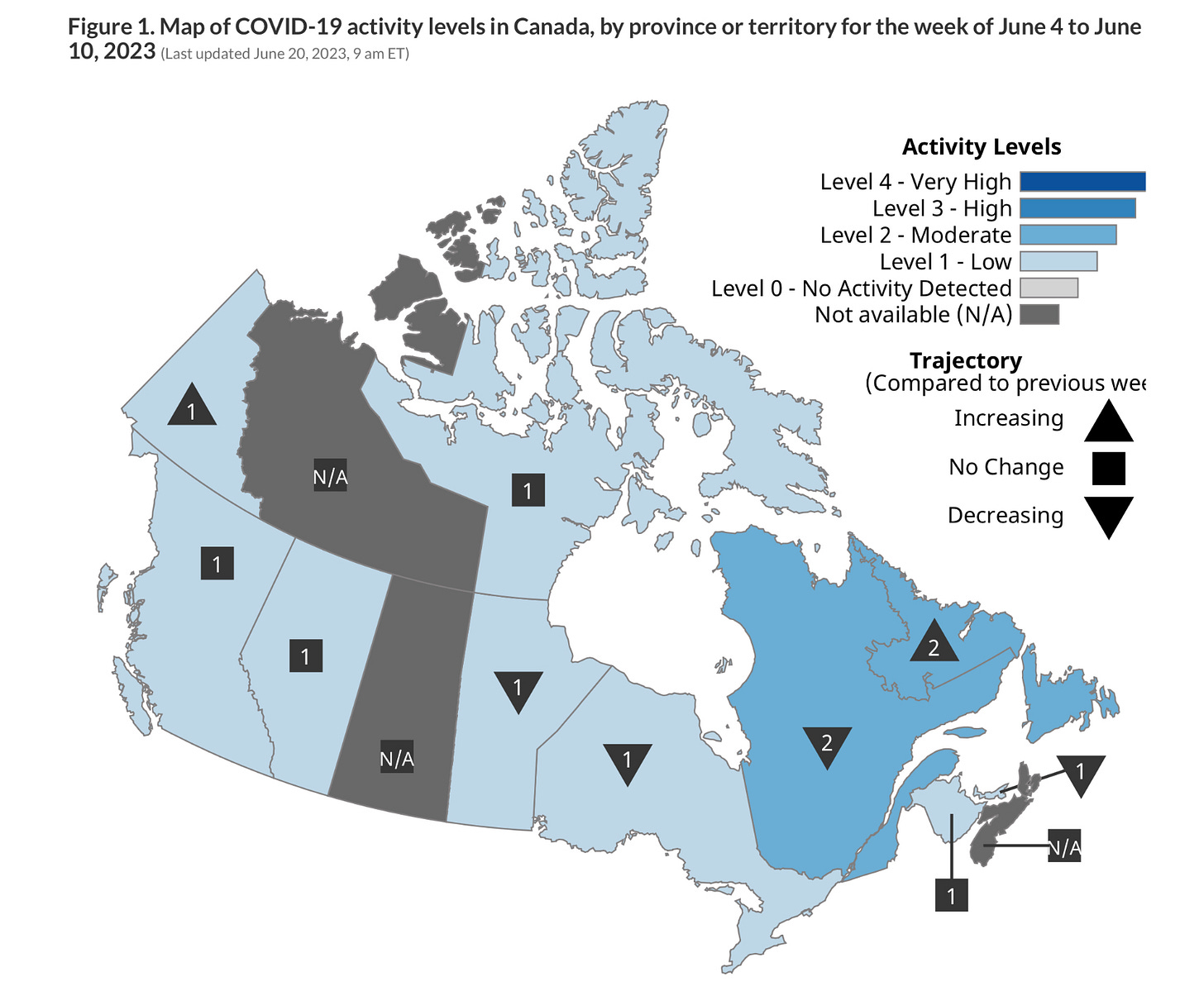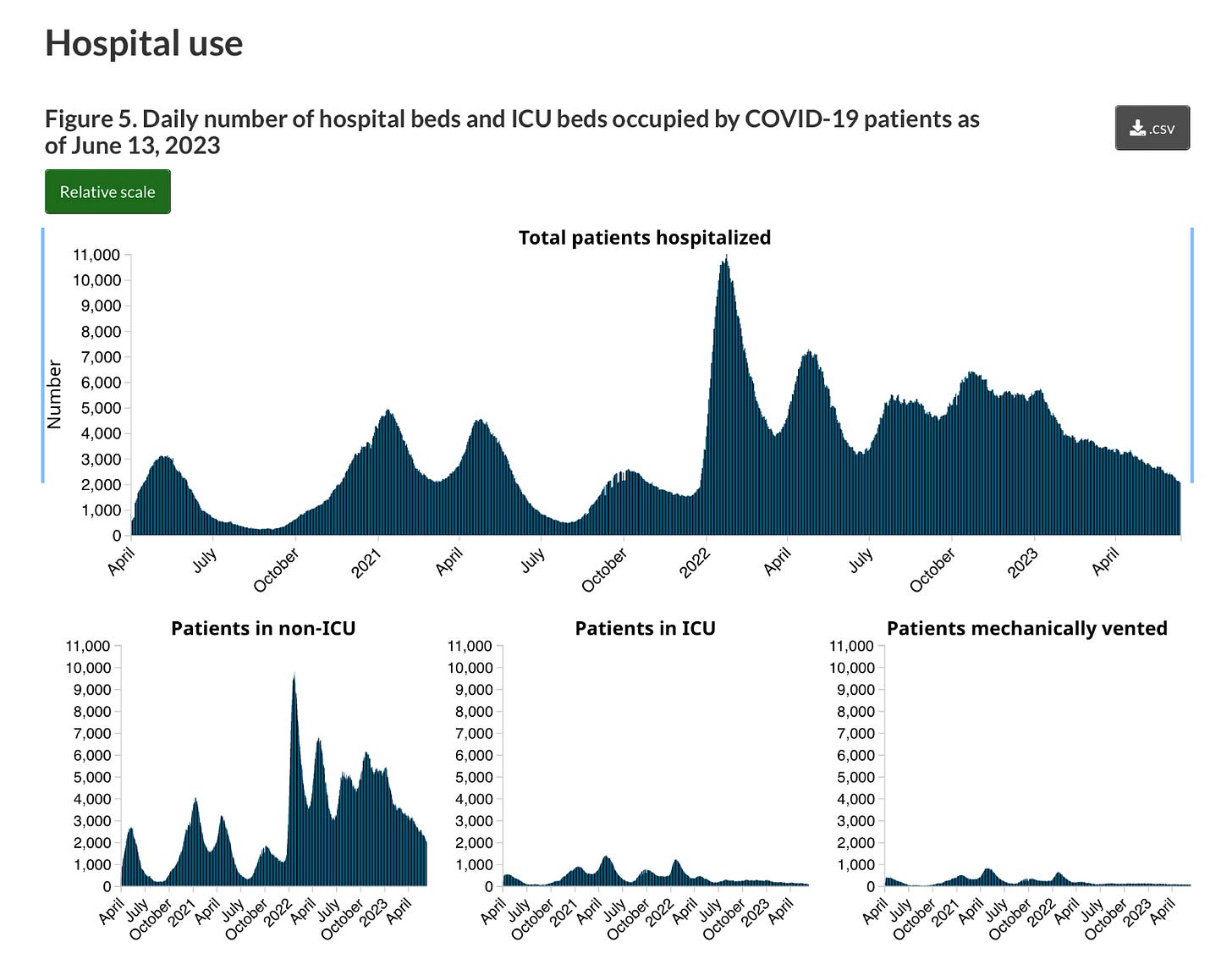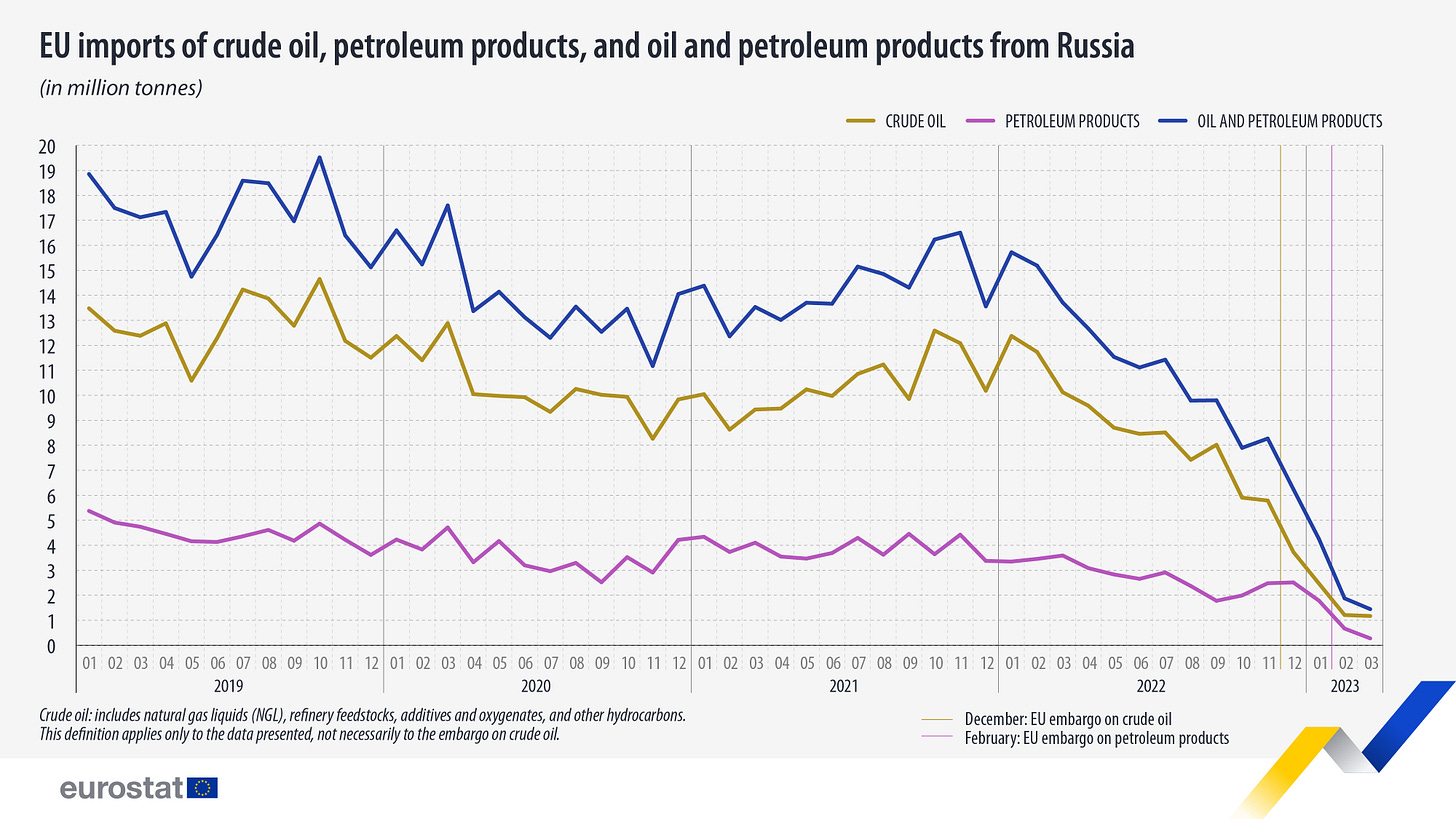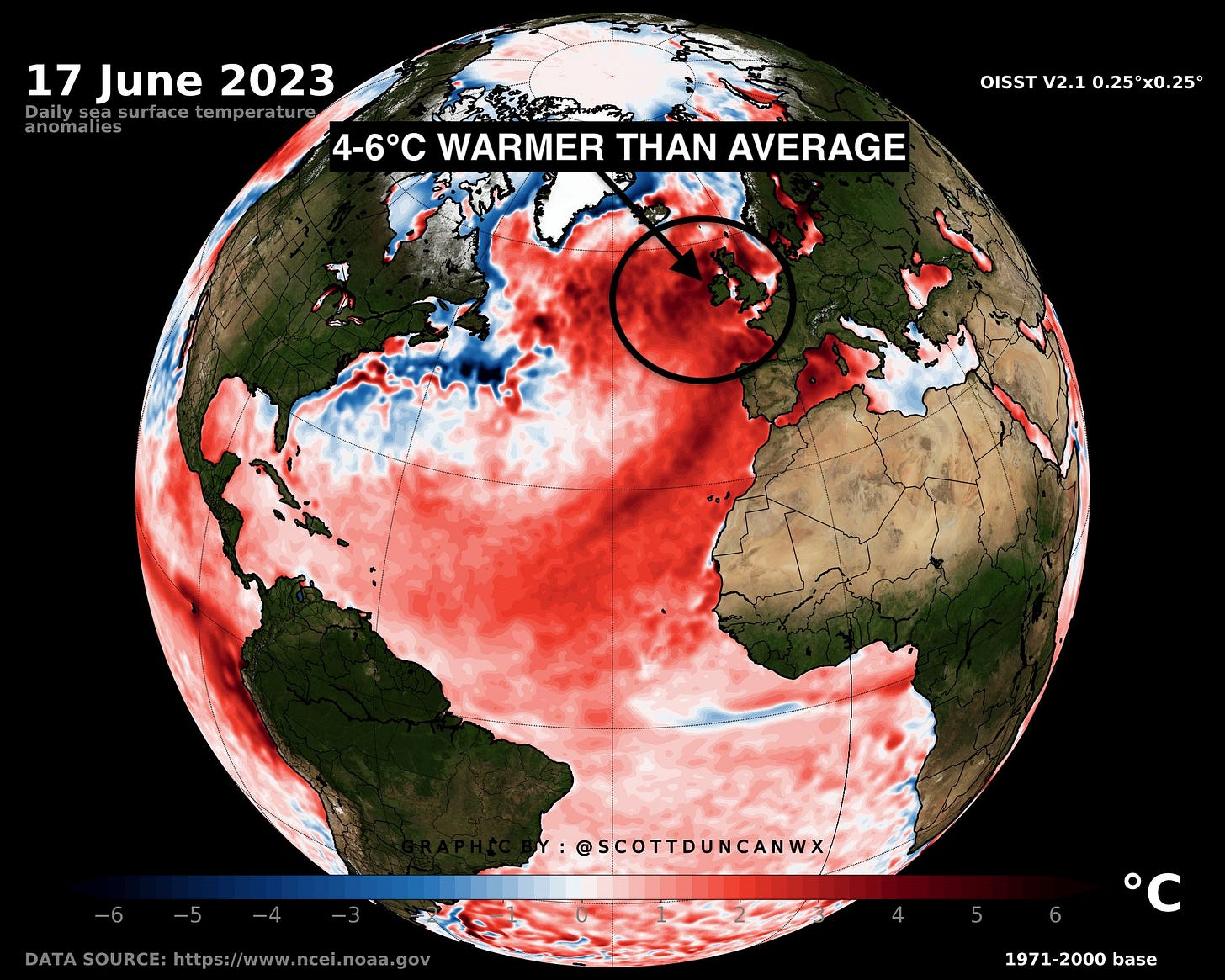The Evening Report - June 22
Drought claims annual Danish tradition. Denmark’s fall booster dose strategy.
☀️Drought☀️
🇩🇰
For most of Denmark, there will be no traditional sankthansbål, or midsummer bonfire, this year. Danish Emergency Services (Danske Beredskaber) have placed almost the entire country under a fire ban due to the severe drought.
For readers not familiar with the Danish tradition, on the evening of June 23, Sankt Hans Aften, large bonfires are lit across the entire country. Often there is an effigy of a witch placed on the top of the bonfire. This dates back to a darker more superstitious time in the country when large fires were lit on the night of the 23rd to ward off witches.
This year Sankt Hans will have to be enjoyed without the traditional bonfire due to fire bans encompassing Jutland, Fyn, Bornholm, and portions of Sjælland.
Emergency Manager Rasmus Storgaard spoke to DR to say the ban on midsummer bonfires will come into force on Friday.
“Restrictions against bonfires have been introduced throughout Jutland, on Funen and in the western and north-western part of Sjælland as well as in Tisvilde Hegn, Helsingør Municipality, and on Bornholm. The ban applies to all types of fires that are lit on Midsummer's Day from the morning of June 23 to the morning of June 24. This applies to all situations, even fires on a raft in a lake and in people's gardens. Bonfires in the part of Denmark where there are restrictions are simply prohibited.”
The fire ban is due to the severe drought in Denmark, which has drastically increased the fire risk. While some rain did finally fall last weekend it was only in small parts of the country and in amounts that just didn’t make enough of a difference.
In the few places where a midsummer bonfire is not prohibited Danske Beredskaber recommends taking safety precautions including keeping the blaze small and having water standing by to extinguish it if necessary. Bonfires should also be completely extinguished before being left unattended.
“We appeal to people's common sense, so when they have been given permission, consider very carefully whether it needs to be the huge pile that needs to be burned. Can it be made smaller and more controllable?”
-
In western Jutland, Blokhus usually hosts a massive midsummer bonfire that draws thousands of people. Due to the fire ban the traditional blaze is no longer an option. So this year the municipality is going to use Plan B. Instead of a bonfire they will utilize smoke cannons and special effects. There will also be singing and entertainment.
-
Areas of Denmark continue to get hit by cloudbursts but the continuous country-wide rainfall needed to alleviate the severe drought remains missing in action. Northern Sjælland has seen a number of cloudbursts this week. Three different parts of Gribskov Kommune saw over 15 millimeters of rainfall in 30 minutes. Græsted got hit pretty hard as well with 26.7 millimeters of rainfall inside half an hour.
But the rainfall remains highly localized and while tiny pockets of the country see some measure of drought relief the country as a whole continues to suffer. The drought index as of Wednesday was sitting at 9.3 nationwide.
🇸🇪
The drought situation in southern Sweden is so severe that more and more farmers are now considering slaughtering their livestock. KLS Butchery told Swedish public broadcaster SVT that they are seeing a significant increase in farmers reaching out to ask about having their animals butchered. From one week to the next the company says calls have increased “by about 100%”. The company says the last time things were this bad was in the drought of 2018.
-
As Sweden struggles with the severe drought it has, in places, moved from fire bans to introducing water restrictions. The water use bans are largely concentrated in municipalities in Southern Sweden.
Red means there is an irrigation ban. Water in a red zone can only be used for food, drink, and personal hygiene.
Orange means there is just an irrigation ban.
Yellow means the municipality is urging residents to voluntarily conserve their water use.
🦠Pandemic🦠
🇩🇰
Denmark’s fall COVID booster dose and influenza vaccination campaign are beginning to take shape. Region Syddanmark has approved its fall inoculation strategy. Both COVID booster doses and the annual flu shot will be available at vaccination centers in the cities of Svendborg, Odense, Esbjerg, Sønderborg, Aabenraa, Kolding or Vejle, while on the island of Ærø vaccinations will be done at the main hospital. The region says it will also work with private clinics, which includes pharmacies, who can also administer inoculations. Family doctors will also be utilized to inoculate seniors in care in their care homes.
But when the COVID booster dose campaign begins on October 1, doses will only be available to select groups. The region says that according to the Danish Health Authority COVID booster doses will only be available to seniors over 65 and all other high-risk groups regardless of age. Those high-risk populations include pregnant women, people with chronic diseases, and those with weakened immune systems.
Region Health Committee Chair Mette With Hagensen:
“This year we will not mass vaccinate as in the past, we will only offer vaccination to those people who are at particularly increased risk of severe infections if they become infected with COVID and influenza. With the decision, citizens are offered a clear vaccination offer with 80-120 vaccination sites across the region. There will thus be a vaccination offer for everyone who is invited for vaccination, both in the local area and in the larger cities.”
All five Danish regions are expected to operate the same vaccination model this fall.
Once again this fall a nasal spray influenza vaccination will also be available for children two to six years old.
During the last vaccination effort, Region Syddanmark administered COVID booster doses to 407,904 people while doing 317,304 influenza vaccinations.
-
The Statens Serum Institute appears to have stopped reporting COVID hospitalization numbers, one of the last true measures of COVID activity. And in its bi-weekly newsletter on infectious disease activity released this week, there isn’t a single mention of the coronavirus.
While we can’t tell you how many coronavirus-infected people are in intensive care or on a ventilator across Denmark we can still see an age breakdown of all virus-related hospitalizations in the last week. 73% of all COVID admissions in the last seven days were seniors over 65.
-
Denmark is also reporting nine more coronavirus deaths in the last week.
🇸🇪
COVID hospitalizations in Sweden (240) have dipped slightly (-14) but the number of severely infected people in intensive care (12) has increased (+6).
🇫🇮
The Finnish Institute for Health has registered 407 new infections and 35 more pandemic deaths in the last week.
🇩🇰 🇬🇧 🇸🇬
According to a new study, COVID was a leading cause of death among children and young people in the United States in 2021 and 2022. Researchers from Denmark, the United Kingdom, and Singapore say the study demonstrates that steps, including vaccination, need to be taken to better protect young people. While the study notes that coronavirus deaths among children are rare when you shift the focus away from just the numbers to leading causes of death by age than its findings become more concerning.
At the time the study was published there were over 1,300 pandemic deaths among young people under the age of 19 in the United States. The U.S. is the only country in the world to record over one-million total COVID fatalities.
Researchers utilized data from the U.S. Centers for Disease Control and Prevention in their study. The study found that among children under the age of 19 COVID was the eighth-highest leading cause of respiratory and infectious disease-related deaths. That increases among younger children. For children under four COVID was the sixth highest leading cause of death, for children five to 14 it was sixth. COVID infections accounted for more deaths among children than either influenza or pneumonia.
Study Author, and University of Oxford Associate Professor Seth Flaxman:
“These results demonstrate that while it's rare for kids and teens to die in the US, COVID is now the leading underlying cause of death from infectious disease for this age group. Fortunately, we now have an array of effective tools to minimize risk, from building ventilation to air purifiers, to safe vaccines. Working together, communities can significantly limit the extent of infection and severe disease.”
The study notes that “it is likely that these results understate the true burden of COVID-related deaths in this age group.”
It concludes that with COVID variants continuing to evolve the study shows that public measures including vaccination, keeping kids home when they are sick, and ventilating indoor spaces, all have an important role to play in limiting infection spread and mitigating severe infections among children.
You can find the study in full HERE.
🇬🇧
According to the COVID Actuaries Response Group COVID-related hospital admissions in England have fallen by 19% week to week. The declines were seen across all regions with London seeing the biggest drop (-19%).
The COVID reinfection rate, or R0, has dropped to 0.86.
🇨🇦
The Public Health Agency of Canada has reported another 2,006 new infections (highly underreported) and 37 more coronavirus deaths in its latest weekly update.
The seven-day positivity percentage is 7.5%.
-
COVID hospitalization numbers have declined across Canada. In the week ending June 13, the total number if hospital beds in use by pandemic patients dropped to 2,054, that is 207 fewer beds than the week before. General admissions saw the biggest drop with 185 fewer patients from week to week with 1,981 admissions. The number of intensive care patients decreased to 73, a drop of 22 from the week prior. There were 63 people on a ventilator, a number that is unchanged week to week.
⚡️Energy & Environment🍃
🇪🇺/ 🇷🇺
Russia’s weaponization of its oil and gas exports to Europe continues to be a strategy of economic disaster. In March, the European Union imported just 1.4 million tons of crude oil and petroleum products from Russia. That is down 90% from the average monthly figure in March in each of the three previous years according to the EU statistics agency, EuroStat.
EU sanctions over the invasion of Ukraine include embargoes on oil and gas imports from Russia. Europe has also put rocket boosters on the energy transition as they seek to sever all energy reliance on Russia. For its part, Russia has literally turned off almost all the taps on oil and gas pipelines into Europe, its once biggest oil and gas customer.
-
In an effort to offset last year’s energy crisis European countries dipped into their oil reserves. Last year, ten European countries saw their emergency oil reserves dip below minimum levels set by the European Commission. They had until March 31, to refill their emergency oil stocks. EuroStat says two have successfully done so, another three are very close, and with just over a week to go five others still have emergency oil reserve levels below the minimum level. They are Bulgaria, Czechia, Ireland, Latvia, and Lithuania.
🇩🇰
Consumer prices have dropped from once lofty heights in Denmark. But, according to Statistics Denmark, they are still 2.9% higher than they were in May of last year.
Dansk Erhev Senior Economist Kristian Skriver spoke to Ritzau to say prices are coming down because to a large degree the energy crisis has also eased.
“This puts a big underline under the fact that the worst months with soaring high price increases are well behind us.”
To compare, the year-over-year increase in consumer prices was a much higher 5.6% in April.
-
There are some puzzling developments in the city of Copenhagen’s latest transportation report. The last report, done during the height of the pandemic, showed explosive growth in people choosing to walk while bicycle, train, bus, and car traffic all saw declines. In the latest report, the energy crisis seems to have driven people back to their bikes and back onto public transit. While pedestrian traffic has come down from once soaring heights it remains at a much higher level than before COVID arrived. Bicycle traffic is also returning to pre-pandemic levels.
Copenhagen’s Mayor of Technology and Environment Line Barfod:
“It is really good news that cycling trips have increased and are on their way back to the level before COVID. It makes for a better city with less congestion, and it is also good for public health when you cycle instead of taking the car. It is a wonderful development.”
The head-scratcher comes with car statistics. While trips using a car in the city have fallen, the number of people owning a car has increased by 13%. To put that into perspective the number of car buyers in Copenhagen is growing faster than the city’s population (+5%) and the number of bicycles (+11% ). The city is also projecting a 13% increase in car traffic by 2035.
“It is surprising that car ownership and the number of cars in Copenhagen continue to increase when the number of trips by car is decreasing. Too many cars sit still most of the time and take up space. Space in the city is a scarce resource, and some of that space can be used better if more people use shared cars, bicycles and public transport instead of cars. We are in a situation in Copenhagen where we have to do something about car traffic. Both to reduce congestion, air pollution and CO2 emissions. It is completely unreasonable that the cars take up so much space in the city.”
🇩🇰 🇸🇪
If you are looking for a little more bang for your Danish buck on your summer vacation this year then a trip to Sweden might be a good fit. The Swedish krone has hit a record low against the Danish krone. 63 Danish kroner could get you 100 Swedish kroner this week. But while this is a big benefit to tourists from Denmark heading to Sweden it is also a double-edged sword. Because of the dollar disparity Swedish companies already struggling with a number of economic woes will face higher costs buying Danish products and that could hurt Danish export orders.
🇮🇪 🇬🇧
Ocean waters off of Ireland and the United Kingdom are experiencing a marine heatwave that scientists at the NOAA Satellite and Information Service are calling “beyond extreme.”
Scottish Meteorologist Scott Duncan adds that “we have not seen the North Atlantic look like this in modern records.”
Out of a marine heatwave scale with five being the worst the hotspots off of the British Isles is a category 5.
🇮🇪
Ireland is not even close to being on track to reach its climate goals by 2030. The Irish government is now scrambling to come up with ideas to try and get the country back on track. One of the proposals on the table is a voluntary culling of about 200,000 cattle to try and cut CO2 emissions. If the idea makes the cut, farmers would have to be compensated. One of Ireland’s climate goals is to cut CO2 emissions from the agriculture sector between four to 20%. According to the Irish Mirror, agriculture was responsible for a whopping 38% of the country’s total emissions.
🇺🇳 🌍
The United Nations has reached a “historic achievement” adopting the world’s first international treaty to protect the planet’s seas and oceans. However, for the treaty to come into force a minimum of 60 countries have to ratify it.
UN Secretary-General António Guterres spoke to delegates after the deal was reached,
“The oceans are the lifeblood of our planet. Today you have pumped in new life and hope, which gives the oceans a chance.”
The majority of the world’s marine environments are in international waters with about one-percent of them being protected. The new treaty opens the door to establishing more protected areas around the globe. The U.N. has set a goal to protect 30% of the world’s oceans and land areas by 2030.
🇺🇦/ 🇷🇺 War
🇺🇳/ 🇷🇺 🇺🇦
Russia killed 136 children in Ukraine last year according to UN Secretary-General Antonio Guterres. The UN has now placed Russia’s armed forces on a list of global law-breakers. The United Nations has also accused the Russian army of mutilating 518 children and carrying out attacks on 480 schools and hospitals in Ukraine.
The report also accused Ukrainian forces of carrying out attacks on schools and hospitals that have resulted in the death of 80 children and the maiming of another 175.
Russia is a permanent member of the international intergovernmental organization.
🇸🇪/ 🇷🇺 🇨🇳
“Democracy, human rights, and the rule of law are regarded as existential threats by autocratic and revisionist states like Russia and China. They view these core principles as threats to the survival of their regimes.”
That is an excerpt from an interim report from the Swedish Defence Commission, an all-party committee tasked with tabling a robust assessment of Sweden’s military, the threats it faces, and what to do about it.
The Commission sees Russia as the most serious long-term threat to Europe’s and Sweden’s security.
“Russia’s aggression against Ukraine, violations of international law, disregard for the European security order, and opposition to free, open, and democratic societies have significantly deteriorated the security situation in Sweden’s immediate neighbourhood and the rest of Europe. Russia’s full-scale invasion of Ukraine and China’s increased territorial claims show that conflicts over territory by military means are once again a reality.”
Saying it is of vital interest to defend Sweden’s independence, sovereignty, and territorial integrity, the commission has made interim recommendations. Among them, it seeks to buff up the army by increasing the number of conscriptions to 10,000. It also wants the country’s Air Force and submarine fleet to be improved and strengthened. Defenses on the strategically important island of Gotland in the Baltic also need to be toughened up.
Calling it the biggest security change in over 200 years in Sweden, the commission says joining NATO will also help improve the security situation in Sweden, across the Nordics, and the Euro-Atlantic region as a whole.
As for China, the commission says while the regime doesn’t pose a direct military threat to Sweden its actions in the Indo-Pacific region are of great concern.
“A major war in the region cannot be ruled out.”
It says the geopolitical tug of war is “making it more difficult to deal with global threats such as climate change, pandemics, attacks on strategic infrastructure, terrorism, violent extremism, and organized crime.”
The Commission’s final report is due on April 26, 2024.
🇪🇺/ 🇷🇺
The European Union has reached an agreement on an 11th sanctions package against Russia for its invasion of Ukraine. This one looks to kneecap efforts by Russia to do an end run around existing sanctions.
Several journalism investigations have documented ways Russia is shipping its oil and gas to so-called ‘laundromat countries’ who in turn sell it back to Western nations imposing sanctions on Russian oil and gas. This latest sanctions package includes a ban on accessing all European ports for any vessel engaging in at sea ship-to-ship transfers of Russian crude oil or petroleum products.
The sanctions also tighten restrictions on goods and technologies that might help the Russian military or its war effort in Ukraine. Chief among these sanctions are restrictions on the sale of “sensitive dual-use goods and technologies” to third countries suspected of selling those items back to Russia. Countries suspected of funneling items to Russia will be added to an EU sanctions list.
The latest sanctions also extend the suspension of European broadcasting licenses to five Russian state-owned media outlets peddling pro-Russian propaganda.
Another 71 people and 33 entities believed to be involved in the illegal deportation of Ukrainian children into Russia have been sanctioned. They are banned from the European Union and all of their assets in the EU will be frozen.
🇩🇰 🇺🇦
Denmark is contributing even more money to help the Ukrainian war effort. A majority of parties in the Danish parliament have agreed to increase military support to Ukraine by 21.9 billion Danish kroner (that is about $4.2 billion Cdn). The new money will be allocated over a number of years. Beginning this year another 7.5 billion kroner will be contributed. This will be followed by 10.4 billion in 2024 and then one billion in each of the following four years.
Acting Finance Minister Morten Bødskov said to DR that Denmark can afford to increase its financial support to Ukraine by taking it from surplus budgets.
“We can afford that, and we must be able to afford that at a time when there is war in Europe. There we have an obligation to help the Ukrainians in their fight for freedom.”
The money will go into a Ukraine fund created by Denmark in order to provide consistent military funding to Ukraine. The funds will also cover training costs, emergency humanitarian aid, and rebuilding efforts. For example, the cost to train Ukrainian pilots on F-16 fighter jets will come from this fund.
In a bit if a sneaky accounting tactic, the Danish government is also using the fund as an argument that it is meeting its NATO-required defense spending target of 2% of its gross domestic product.
🇺🇸 🇩🇰 🇺🇦
While Ukraine fights to repel Russian invaders, The United States and its Western allies are working to firm up global support for Ukraine and against Russia. Copenhagen will be the setting this weekend as U.S. National Security Advisor Jake Sullivan meets with representatives from a number of developing countries that have been slow to condemn Russia’s invasion of Ukraine. The Financial Times, citing anonymous sources, reports that the complete list of participants is not yet clear but representatives from India, Brazil, and South Africa will be in attendance.
The Danish Foreign Affairs Ministry would neither confirm nor deny the report.
South Africa has been of particular concern as it has hosted China and Russia for naval exercises. The country’s president has also made some relatively pro-Putin comments. A delegation from South Africa recently visited Ukraine and Russia in a gaffe-ridden attempt at establishing peace negotiations between the two countries.
🇩🇰 🇸🇪 🇳🇴 🇫🇮 🇮🇸
Defense Ministers from Denmark, Sweden, Norway, Finland, and Iceland met in Reykjavik this week. In a joint statement the ministers noted that increased military cooperation among the Nordic nations is vital to the region’s security and to counter any threat by a suddenly aggressive Russia.
To that end, the ministers noted that with all but one of the Scandinavian nations being members of NATO “it is therefore imperative that Sweden joins the Alliance as soon as possible.”
🇬🇧/ 🇷🇺
The British Royal Air Force has scrambled jets twice in as many days this week to intercept Russian aircraft flirting with NATO airspace. On Wednesday, British Typhoons were scrambled from a NATO air base in Estonia to intercept a Russian Navy Tu-134 and two Su-27 ‘FLANKER’ Bs. The RAF says the Russian aircraft was close to NATO airspace and “failed to comply with international norms by not liaising with regional airspace control agencies.”
Then on Thursday night, another Tu-134 and two Su-27s were intercepted returning to Russia from the Russian enclave of Kaliningrad. Once again, the RAF note the Russian aircraft were not complying with international norms.
🇸🇪 🇺🇸
For the first time ever U.S. Air Force Lancer supersonic strategic bombers have landed on Swedish soil. The planes were training with their Swedish counterparts before making a little history.
🇨🇦 🇱🇻
Canada is dispatching a squadron of 2A4M Leopard tanks to NATO’s enhanced forward presence battle group stationed in Latvia. The country’s Prime Minister, Krišjānis Karinš, hails the move as part of a “continuous effort to strengthen the security of our region.”
🇱🇻 🇺🇦
Latvia will transfer its entire fleet of decommissioned helicopters to Ukraine. This includes three Mil Mi-2 transport helicopters and at least four Mil Mi-17 attack/transport helicopters. The country is in the process of upgrading its helicopter fleet.
🇩🇪 🇺🇦
Hensoldt, a German Aerospace Defense company, says it plans to upgrade Ukraine’s helicopter fleet with advanced airborne missile protection systems and other electronic self-defense systems.
-
German Chancellor Olaf Scholz is tapping the brakes on the idea of Ukraine being fast-tracked into NATO. In a speech to the German parliament, Scholz said giving Ukraine security guarantees and supplying it with a steady stream of weapons to defeat Russia should be the two top priorities at the moment.
“We must look soberly at the current situation. Therefore, I suggest that we focus on the top priority in Vilnius (NATO’s summer summit site), namely strengthening Ukraine's fighting power. Our goal is strong military support for Ukraine, including with modern Western weapons.”
Scholz cited comments by the Ukrainian government that it cannot become a NATO member nation as long as it is fighting an active war on its territories.




